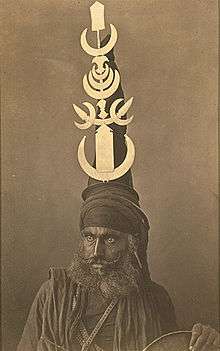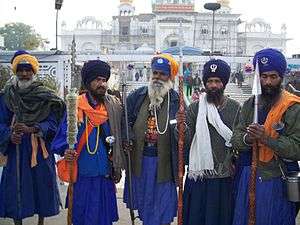Nihang


The Nihang (Punjabi: ਨਿਹੰਗ) are an armed Sikh warrior order.[1] They are also referred to as Akali (lit. "the immortals"). Nihang are believed to have originated either from Fateh Singh and the attire he wore[2] or from the "Akal Sena" (lit. Army of the Immortal) started by Guru Hargobind.[3] Early Sikh military history was dominated by the Nihang, known for their victories where they were heavily outnumbered. Traditionally known for their bravery and ruthlessness in the battlefield, the Nihang once formed the irregular guerrilla squads of the armed forces of the Sikh Empire, the Sikh Khalsa Army.
Etymology
Nihang may come from the Persian word for a mythical sea creature (Persian: نهنگ).[4] The term owes its origin to Mughal historians, who compared the ferocity of the Akali with that of crocodiles. The meaning of Akali in Sikhism, however, is the immortal army of Akal(god)[5]
Arms and attire
Traditional Nihang dress is known as Khalsa Swarupa. This comprises full attire of superelectric blue selected [6] by Guru Gobind Singh Ji, edged bracelets of iron round their wrists (jangi kara) and quoits of steel (chakram) tiered in their lofty conical blue turbans, together with the traditional dagger carried by all Sikhs (kirpan).[7] When fully armed a Nihang will also bear one or two swords (either the curved talwar or the straight khanda) on his right hip, a katar (dagger) on his left hip, a buckler made from buffalo-hide (dhala) on his back, a large chakram around his neck, and an iron chain. In times of war, arms worn on the Nihang's person would generally be reserved until the warrior lost the weapon he held, often a bow or spear (barsha). Armour consisted of sanjo or iron chainmail worn under an iron breastplate (char aina). Nihang war-shoes (jangi mojeh) were constructed of iron at the toe, making their pointed toes capable of inflicting cuts and stab wounds.
The Nihang were particularly famous for their high turbans (dastar bunga) and their extensive use of the chakram or war-quoit. Their turbans were often pointed at the top and outfitted with a chand torra or trident which could be used for stabbing in close-quarters. Other times, the turbans would be armed with a bagh naka (iron claw) and one or several chakram to slice at an opponent's eyes. These steel-reinforced turbans, it was said, afforded enough protection so that there was no need for any other form of headgear. Today, Nihang still wear miniature versions of five weapons (pancha shastra) in their turbans, namely the chakram, the khanda (sword), the karud (dagger), the kirpan, and the tir (arrow).
Nihang today

Nihang today are accorded great respect and affection by sections of the Sikh community, but they have separate beliefs and certain practices. Even though meat consumption with the jhatka method, is not banned in Sikhism. While the order is primarily ceremonial, they are duty-bound to defend their people and faith in times of war. On the festival of Hola Mohalla, Nihang gather in their thousands at Anandpur, in the state of Punjab, India. Located near the Sutlej River, the city is one of the most sacred places in Sikhism, where they display their martial skills.
Use of intoxicants

Some Nihang groups consume cannabis or shaheedi degh (ਭੰਗ) to help in meditation.[8] [9][10] Sukha parshaad (ਸੁੱਖਾ ਪ੍ਰਰਸਾਦ), "Dry-sweet", is the term Nihang use to refer to it. It was traditionally crushed and taken as a liquid, especially during festivals like Hola Mohalla. It is never smoked, as this practice is forbidden in Sikhism.[11]
In 2001, Jathedar Santa Singh, the leader of Budha Dal, along with 20 chiefs of Nihang sects, refused to accept the ban on consumption of shaheedi degh by the apex Sikh clergy - in order to preserve traditional sikh practices.[12] According to a recent BBC article, "Traditionally they also drank shaheedi degh, an infusion of cannabis, to become closer with God"[13]
See also
Notes
- ↑ Brard, Gurnam (2007). East of Indus: My Memories of Old Punjab. Hemkunt Press. p. 185. ISBN 9788170103608.
- ↑ Surjit, Gandhi (2007). History of Sikh Gurus Retold: 1606-1708 C.E, Volume 2 of History of Sikh Gurus Retold. Atlantic Publishers & Distributors. p. 999. ISBN 9788126908585.
- ↑ Singh, Khushwant (1999). A History of the Sikhs Volume I:1469-1839. India: Oxford University Press. p. 215. ISBN 0-19-562643-5.
- ↑ Taba, David (2011). Iranian Character of The Armenian Language. p. 9.
- ↑ Singh, Khushwant (1999). A History of the Sikhs Voghzlume I:1469-1839. India: Oxford University Press. p. 215. ISBN 0-19-562643-5.
- ↑ Macauliffe, Max Arthur (1909). The Sikh Religion: Its Gurus, Sacred Writings and Authors Volume 5. United Kingdom: Cambridge University Press. p. 210. ISBN 978-1-108-05547-5.
- ↑ Mayled, Jon (2002). Sikhism. Heinemann. p. 23. ISBN 9780435336271.
- ↑ Richard Beck, David Worden. Gcse Religious Studies for Aqa. p. 64. ISBN 0-435-30692-8.
- ↑ Hola Mohalla: United colours of celebrations,
- ↑ "Mad About Words". Telegraphindia.com. 2004-01-03. Retrieved 2014-01-04.
- ↑ "UCSM.ac.uk". Philtar.ucsm.ac.uk. Archived from the original on 2010-10-16. Retrieved 2014-01-04.
- ↑ Nihangs ‘not to accept’ ban on shaheedi degh. The Tribune. March 26, 2001.
- ↑ Hegarty, Stephanie (2011-10-29). "BBC News - The only living master of a dying martial art". Bbc.co.uk. Retrieved 2014-01-04.
References
- Dasam Granth , The Dasam Granth website
- Book review of the Nihang book The Beloved Forces of the Guru
- "Tribes and Castes of Punjab and N.W. Frontier Province" by H.A. Rose (1892)
- Bhai Sahib Amrit Pal Singh 'Amrit' has presented well-researched articles on Nihangs on his website
- www.Budhadal.com
External links
- Sikh Photography Images of Nihangs by photographer Charles Meacham
- Sarbloh.info
- Nihangsingh.org
- Nihang SGPC
- Photography of the daily lives of the Nihang Singhs of Punjab by photographer Nick Fleming